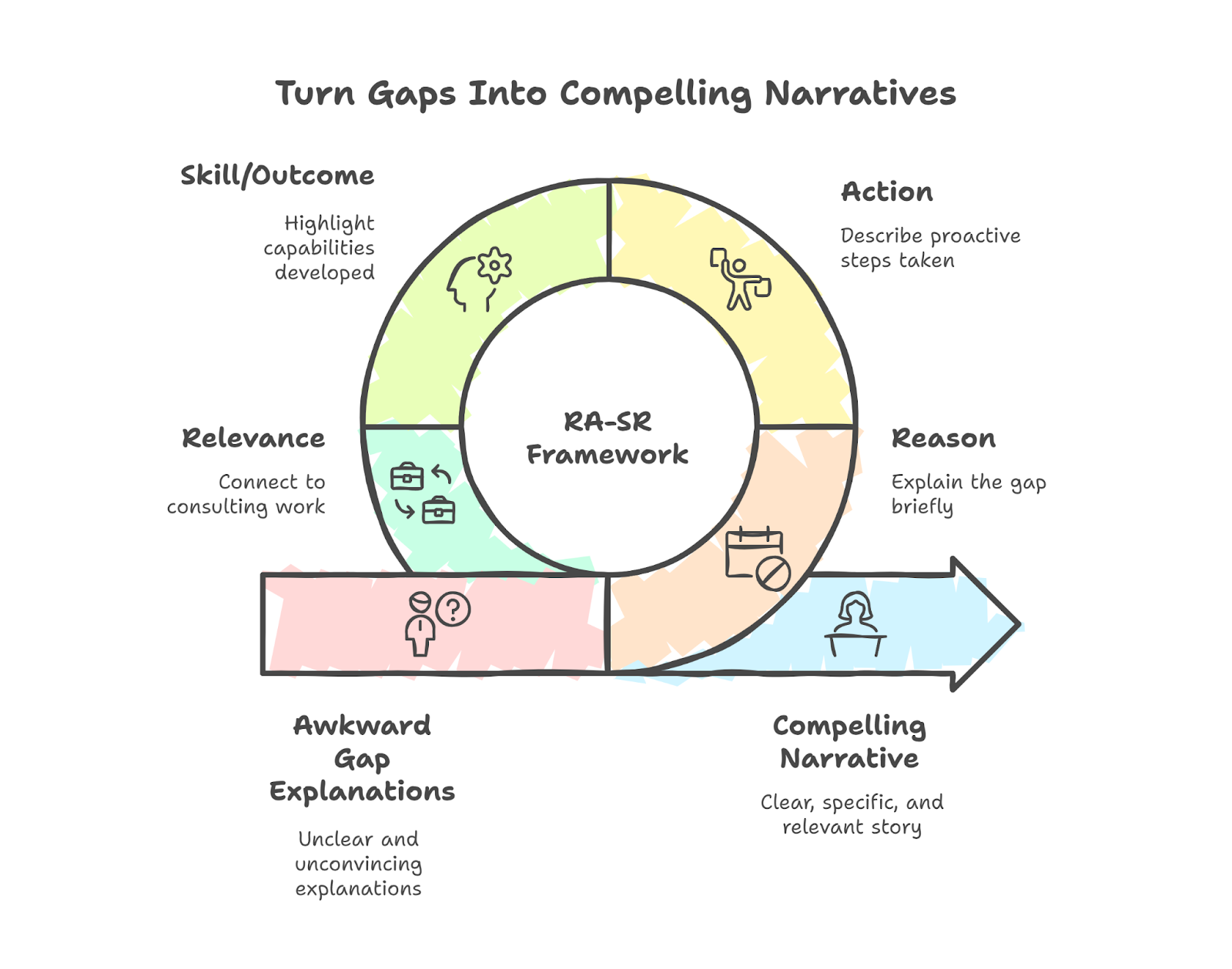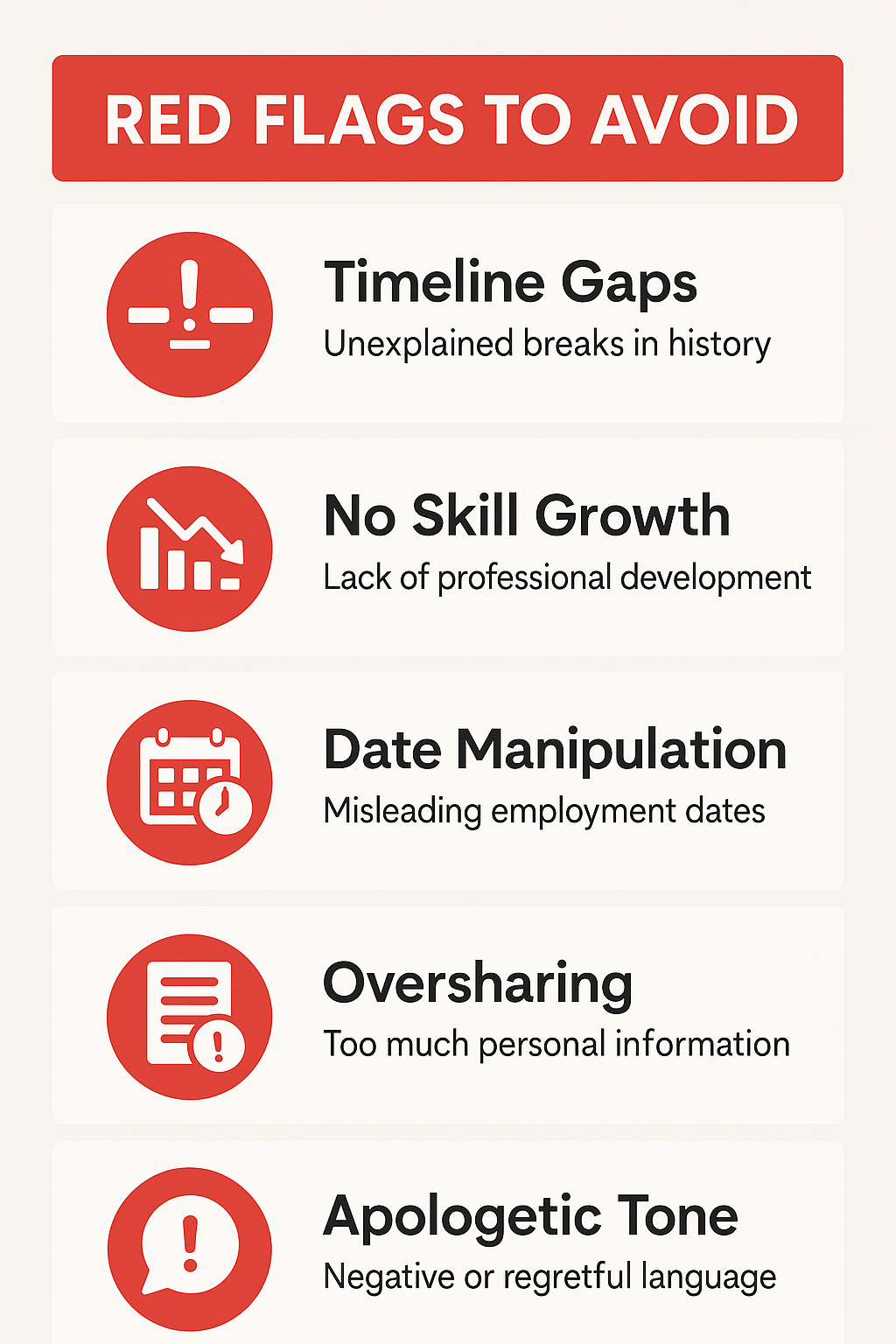Have you been wondering if your gap year will hurt your chances of landing that dream consulting role? Or perhaps you’re unsure how to explain it effectively in your application materials? You’re not alone.
The good news? The stigma around career breaks is rapidly fading.
According to recent McKinsey data, 79% of hiring managers now say they will still hire candidates despite resume gaps.
Let me share what I learned during my time at McKinsey: consulting firms care less about perfect chronology and more about what you did with your time and how you talk about it. A well-positioned gap year can strengthen your application.
In this guide, I will show you exactly how to transform a potential weakness into a compelling strength that makes recruiters take notice.

What Actually Counts as a “Gap Year”?
In consulting recruitment, a gap year typically means any intentional or involuntary break of approximately 6 months or more between jobs or between graduation and employment.
This differs from brief “white space” periods under 6 months that naturally occur during academic transitions or job changes.
Most consulting recruiters now recognize that career paths aren’t always linear.
The data shows a remarkable shift in employer attitudes:
- 79% of managers will hire candidates despite resume gaps
- 81% of firms have adopted skills-based hiring, where capabilities matter more than perfect chronology
- Major consulting firms like PwC now offer formal return paths for professionals after career breaks
“The old stigma around gaps is fading fast,” a senior McKinsey recruiter told me last month. “We care much more about what you did during that time and how you talk about it.”
Common Types of Gap Years Consulting Recruiters See
Consulting recruiters regularly encounter several types of career breaks:
| Category | Examples recruiters see most often | Credibility signals to emphasise |
| Skill-building sabbatical | Coding bootcamp, language immersion, data analytics cert | Quantifiable coursework hours, certificates |
| Entrepreneurial venture | Start-up, freelance consulting, e-commerce store | Revenue, users, or process innovations |
| Travel/service | Structured volunteer program, Teach For All, Peace Corps | Measurable impact, cross-cultural adaptability |
| Caregiving or health | Caring for a family member, personal medical leave | Resilience narrative, time management |
| Market-driven layoff | Post-pandemic downsizing, sector contraction | Rapid upskilling, networking, and temp projects |
The RA-SR Framework: A Proven Gap Year Storytelling Method
During my years coaching consulting candidates, I’ve developed what I call the RA-SR Framework. This simple but powerful structure turns awkward gap explanations into compelling narratives:
Reason → Action → Skill/Outcome → Relevance to consulting

This framework works because it mirrors how consultants communicate: clear context, specific actions, measurable outcomes, and business implications.
- Reason: Briefly explain why the gap occurred (one sentence, no apologies).
“Visa delays paused my graduate program.”
- Action: Describe what you proactively did during the time
“I built a no-code pricing tool for a local NGO.”
- Skill/Outcome: Highlight the capabilities you developed
“I strengthened my rapid prototyping and cost-benefit analysis abilities.”
- Relevance: Connect directly to consulting work
“This experience mirrors how your digital practice accelerates MVPs for clients.”
The beauty of this framework lies in its adaptability across application materials and interview settings.
Real Examples of RA-SR in Action
For a travel gap year: “After graduating, I took a year to volunteer in Southeast Asia (R). I led projects teaching English in rural communities (A), which honed my cross-cultural communication and leadership skills (S). These experiences prepared me to adapt quickly to diverse client environments at BCG (R).”
For entrepreneurial time: “Between roles, I spent a year launching an e-commerce business (R). I built the business model, managed the P&L, and acquired 2,000+ customers (A). This developed my strategic thinking and customer acquisition expertise (S), which aligns perfectly with Bain’s emphasis on practical, implementable solutions (R).”
The framework ensures you never leave the interviewer wondering about unexplained time or your readiness to return.
How to Optimize Your Resume to Address a Gap Year
Your resume represents your first opportunity to control the gap year narrative.
Strategic Placement on Your Resume
The best placement depends on what you did during your break:
If you gained valuable, relevant experience, list it under “Professional Experience” with clear dates and outcomes.
If it was primarily personal, create a dedicated “Career Break” section following your work history.
If you gained educational credentials, include them under “Education” or “Professional Development.”
The key is avoiding unexplained timeline gaps that make recruiters question your history.
Creating an Effective Gap Year Entry
Some recruiters specifically recommend including a dedicated line with:
- Clear label (“Career Break”, “Professional Sabbatical”)
- Precise dates (month/year to month/year)
- Concise explanation
- Quantifiable outcomes
Example:
Career Break | Jan 2023 – Dec 2023
Full-time caregiver; completed 300 hr Google Data Analytics certificate; led pro bono market sizing for local NGO (saved 15% operational costs).
Common Resume Mistakes to Avoid
Never try these tactics that immediately raise red flags with consulting recruiters:
- Using “years only” dates to mask gaps
- Leaving unexplained time periods
- Stretching employment dates to cover gaps
- Overly vague descriptions of gap year activities
“Consulting firms conduct thorough background checks,” warns a former BCG recruiter. “Transparency builds trust. Manipulation destroys it.”
How to Craft Your Gap Year Narrative in Cover Letters
Your cover letter provides space to contextualize your gap year and weave it into your larger professional story.
When and Where to Address the Gap
For significant or recent gaps, address them directly in the second paragraph of your cover letter. This prevents the recruiter from forming their assumptions as they read.
For older or shorter gaps, you might integrate the explanation more naturally into your career narrative, focusing on the transition between roles.
Either way, never hope the gap goes unnoticed. Proactive explanation demonstrates confidence and maturity.
Sample Paragraph Template
Here’s a template based on successful cover letters:
“After [previous position/graduation], I made the deliberate decision to [reason for gap] from [month/year] to [month/year]. During this time, I [key action/accomplishment], which allowed me to develop [specific skills]. This experience strengthened my [consulting relevant trait], which I’m eager to bring to [firm name]’s [specific practice area].”
Balancing Brevity with Explanation
Keep your gap explanation to 2-3 sentences maximum. The cover letter’s primary purpose remains showcasing your fit and enthusiasm for the role, not dwelling on the gap.
The explanation should follow the Clear → Concise → Compelling progression, with emphasis on the latter two elements.
Linking to Consulting Skills
Every skill mentioned should connect directly to consulting work:
- Cross-cultural experience → global client adaptability
- Project management → structured problem solving
- Data analysis → insights-driven recommendations
- Stakeholder management → client relationship skills
This answers the “so what?” question before the recruiter can ask it.
Tone Considerations
Adopt a confident, matter-of-fact tone rather than an apologetic one. Language like “unfortunately” or “I had to” signals insecurity.
Compare:
❌ “Unfortunately, I had to take time off after being laid off.”
✅ “Following my company’s restructuring, I used the opportunity to strengthen my quantitative toolkit through…”
The first sounds defensive; the second shows agency and a growth mindset.
How to Discuss Gap Year in Consulting Interviews
The interview represents your final chance to control the gap year narrative, with the added challenge of doing so in real time.
Preparing for Common Questions
Be ready for direct questions like:
- “I notice you took some time off between roles. Can you tell me about that?”
- “What did you do during the period from [month] to [month]?”
- “How did your time away from work/studies prepare you for consulting?”
The key is having a practiced but natural response that follows your RA-SR framework.
Prepare a 30-Second Response
Draft and practice a concise explanation using the RA-SR framework. For example:
“When my company downsized last year [Reason], I used the opportunity to complete an intensive coding bootcamp and build a pricing analytics tool for a local nonprofit [Action]. This strengthened my technical toolkit and project management abilities [Skill], allowing me to bring more value to clients needing data-driven solutions [Relevance].”
Keep it brief. Be ready to expand if asked, but don’t volunteer excessive details.
Adapting to Different Interviewers
Partner/Principal interviews: Focus on strategic growth and long-term career vision. Show how your gap year fits into a coherent professional narrative.
HR interviews: Emphasize consistency with your application materials and readiness to commit fully to the consulting role now.
Case interviewers: Briefly address the gap if asked, then demonstrate that your analytical abilities are sharp regardless of any break.
Throughout all interactions, project confidence that your unique path is an asset, not a limitation.
Addressing Specific Gap Year Scenarios
Different types of gaps require tailored approaches. Let’s examine the most common scenarios.
Market-Driven Layoffs
For pandemic or economic downturn-related layoffs:
- Emphasize it was part of a broader market correction, not performance-related
- Highlight immediate steps taken to maintain skills and network
- Showcase temporary or project work undertaken
- Demonstrate continued industry engagement through events, courses, or content creation
Example statement: “Following the industry-wide contraction that affected 30% of my former colleagues, I immediately focused on enhancing my technical skills through [specific actions] while maintaining client relationships through freelance advisory work.”
Health or Family Care Gaps
For personal or family health situations:
- State the reason briefly without unnecessary medical details
- Focus primarily on recovery and readiness now
- Highlight any concurrent professional development
- Express enthusiasm for fully committing to the new role
Example statement: “I took eight months to support my mother through treatment. During this time, I also completed an online finance certificate and maintained connections with my professional network. I’m now fully ready to devote my energy to consulting.”
Travel and Volunteer Experiences
For gap years focused on travel or service:
- Frame as deliberate, structured experiences rather than extended vacations
- Emphasize leadership roles and measurable contributions
- Highlight cross-cultural competencies developed
- Connect the experiences to global business awareness
Example statement: “My structured 10-month volunteer program in Southeast Asia gave me firsthand experience managing projects across cultural boundaries. I led a team of 12 local staff, increased educational outcomes by 40%, and developed adaptability skills crucial for consulting environments.”
Entrepreneurial Ventures
For startup or independent business attempts:
- Treat it as a legitimate professional experience, regardless of the outcome
- Emphasize business model development and market analysis
- Quantify customer acquisition, revenue, or user growth
- Extract strategic learnings, even from challenges
Example statement: “As founder of TechStart, I developed the business model, secured seed funding of $50K, and grew our user base to 3,000 customers. While ultimately deciding to return to consulting, this experience strengthened my ability to think holistically about business problems.”
Multiple or Extended Gaps
For candidates with several breaks or one very long gap:
- Create a coherent narrative that shows progression
- Group related activities under one focused explanation
- Demonstrate recent, relevant work (even if volunteer or project-based)
- Directly address your commitment to stability in consulting
Example statement: “My extended career break encompassed three phases: first, caregiving for my father (6 months); second, completing my data science certification (4 months); and finally, applying those skills through pro bono consulting work (5 months). This progression reflects my methodical approach to personal and professional growth.”
Our High Bridge coaches have helped candidates successfully navigate every type of gap year scenario imaginable. Through targeted practice and feedback, even the most challenging gaps can be transformed into compelling narratives that highlight your unique value.
Red Flags to Avoid When Explaining Your Gap Year
Even with the growing acceptance of nonlinear careers, certain approaches will harm your chances:

Unexplained Timeline Inconsistencies
Recruiters quickly spot when dates don’t align across your materials. Ensure your gap year timeline matches exactly on your resume, LinkedIn, application forms, and interview responses.
To avoid this pitfall, create a single document with your precise dates and explanations, then reference it when completing any application materials.
Lack of Skill Progression
A gap showing zero professional development raises serious questions about your motivation. Always highlight at least one way you grew professionally during your break, even if informal.
This could be a course, self-directed learning, or volunteer work. The solution is simple: identify at least three skills you developed during your gap and be ready to discuss how you built them.
Date Manipulation Tactics
Never try to hide gaps through formatting tricks like using “years only” or creating overlapping positions. Recruiters view these attempts as deliberate misrepresentation.
Instead, embrace transparency with clear month/year formatting and accurate dates. Honesty builds trust, while manipulation destroys it.
Over-Explaining Personal Circumstances
While honesty matters, too many personal details create discomfort. Keep explanations of health or family matters brief and professional.
A good rule of thumb is to limit personal explanations to one sentence, then immediately pivot to what you accomplished during that time.
Apologetic Framing
Phrases like “Unfortunately…” or “I hope you can overlook…” suggest you view your gap as a failure rather than a growth opportunity.
Remove apologetic language from your explanations entirely. Practice telling your gap year story with confidence, focusing on deliberate choices and outcomes rather than justifications.
Background Check Considerations
Remember that consulting firms thoroughly verify your history. Ensure all employment dates are accurate and any paid work during your gap is disclosed.
Before submitting applications, verify that your explanation could withstand a background check. If parts of your story aren’t verifiable, focus on the elements that are.
How long is “too long”?
This is a question I hear constantly from anxious candidates. While perceptions are changing, research from consulting recruiters suggests that gaps exceeding 18 months begin raising concerns about skill decay and industry currency.
When your gap stretches beyond this threshold, the burden of proof increases. You’ll need to demonstrate recent, relevant project work that proves your skills remain sharp.
I’ve worked with candidates who successfully explained two or even three-year gaps, but they had compelling stories of continuous learning and typically some form of part-time professional engagement during the latter portion of their break.
The key to longer gaps is showing a clear trajectory back toward professional engagement. Perhaps you started with full-time caregiving, then added online courses, then took on freelance projects. This progression demonstrates intentionality and commitment.
Remember, though, the same RA-SR framework applies regardless of gap length. The principles remain consistent, but for extended breaks, place extra emphasis on the Action and Skill elements to counter potential concerns about skill atrophy.
Final Words
The perception of career gaps has fundamentally changed. What once might have been a significant barrier to entry in consulting is now, with proper positioning, an opportunity to demonstrate maturity and a unique perspective.
Remember these core principles:
- Use the RA-SR Framework to structure your explanation (Reason → Action → Skill/Outcome → Relevance)
- Quantify everything possible about your gap year experience
- Label gaps clearly with precise dates on your resume
- Address significant gaps proactively in your cover letter
- Practice confident, concise interview responses
- Connect gap year activities directly to consulting relevant skills
- Maintain complete consistency across all application materials
- Frame your unique path as a strategic advantage
The most successful candidates approach their gap year with the same analytical mindset they bring to case interviews: they identify the key message, structure their communication logically, and focus on relevant outcomes.
Your career break is part of what makes you unique. By applying the strategies in this guide, you can ensure it becomes an asset rather than an obstacle in your consulting journey.
Take the next step: Schedule a free discovery call with us. Our proven methodology has helped candidates with non-traditional backgrounds secure offers at rates 20x higher than the industry average.


